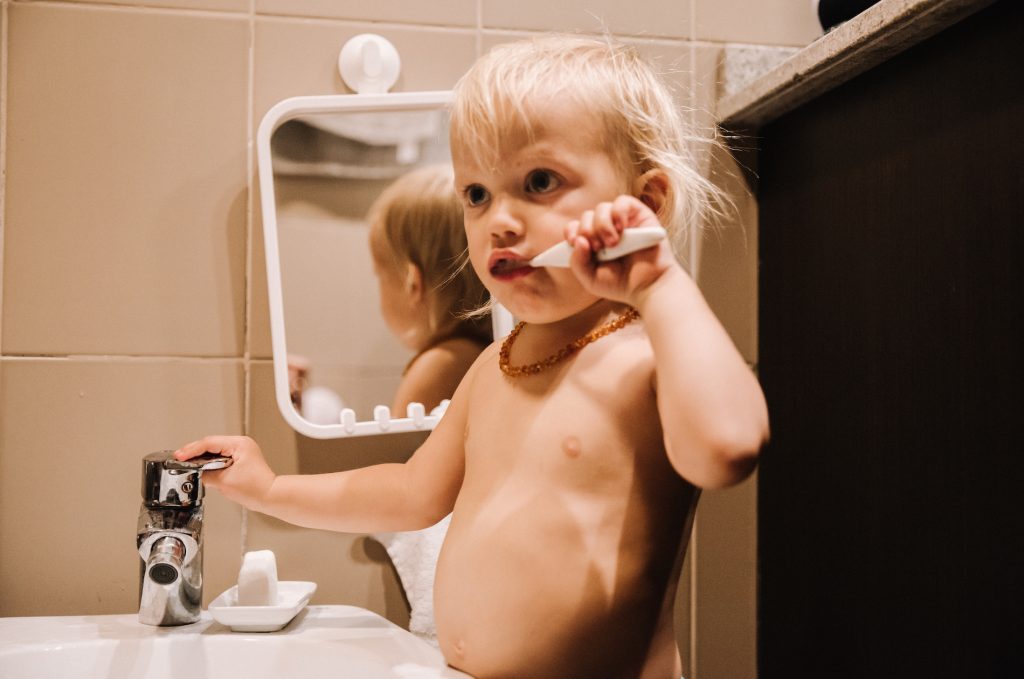The process of grounding and centering our child in preparation for a restful night for all of the family is as important as the practical arrangements for bedtime.
You seek to share some moments of magical stillness, creating a meaningful ritual for those last waking minutes before your child slips into sleep, the final part of the rhythm of your day. Children, even more so than adults, process the events of their day whilst they sleep, so a conscious unwinding is essential to allow their transition to dreamland to be a peaceful one.
Once you have finished her bedtime story, you can turn off the main lights, leaving just the red night light on. Lie down on her floor bed next to her and start with a deep breathing ritual to settle her and yourself in order to prepare her for sleep.
You can make this deep breathing quite loud, and clearly audible to your child so that she can hear what you are doing. Place one hand on your tummy and one on your heart as you do this so you can feel your tummy and chest expanding and contracting. Placing your hands on your body emphasises the inhalation and exhalation. From when she is a few months old you can invite her to do the same, placing one hand on her tummy and on her chest as you breathe deeply together.
A newborn, of course, won’t be able to roll over and see what you are doing, but an older baby will roll over, sit up to get a better view, shuffle closer. Encourage her to join you in lying down, breathing deeply and connecting. If she is crawling or moving around the room then let her do what she needs to do and continue with your relaxation.
This deep breathing in tandem connects the two of you. If work schedules permit for the partner who works outside the home to do this bedtime ritual then it will be a beautiful and meaningful way for them to connect with their child after the day apart. Just breathe deeply together, offering your complete presence and awareness in this situation.
Learning how to soothe and calm oneself (with the support of a parent) is an invaluable skill which is absorbed and internalised so it becomes part of who your child is.
The effects of this, like everything else are cumulative and developed over many years, throughout early childhood until age 6. This is not outcome driven – something that can be taught in a few months so that we can move onto the next thing. This is a ritual followed every evening (or as often as is possible) so that our child experiences the intrinsic value in it. We are not able to measure the effectiveness of this practice, and we may feel as if we don’t see a change or the benefit of it, at least not when they are little. But we know in our hearts that this is the right path for them and for us, this settling and grounding in the early years lays invaluable foundations for their future contentment and resilience.
After a few minutes of this ritual of breathing in tandem you can start talking through the story of your day together; what you did, who you saw, what the highlights were for you, and what might have resonated for her.
Allow this to be a conversation that she can participate in. Give her time to answer you and comment as you talk through the day. You can also sing softly to her, and invite her to sing to you too.

Being on a floor bed means that you both will be comfortable for this bedtime ritual. Taking this special time to just be with her is as good for you as it is for her. Whether you have been at work all day outside the home or in the home, you need this rest, this peace that comes as your child slips into sleep.
As adults, we will have many things yet to accomplish once our child has gone to bed, before our day can end, so taking these quiet moments of absolute relaxation will rejuvenate us for our evening’s work. Thinking of activities yet to be completed, it can be challenging to slow oneself down, and not rush through this relaxation process; after all, what we really want at the end of the day is for our child to go to sleep so we can get on with what we need to. It does take a Herculean effort on our part to push back on our desire to move onto the next thing and instead be with them physically, emotionally and spiritually at this time.
Five steps to your bedtime connection ritual:
- Allow fifteen minutes after bath and storytime for the bedtime ritual. Leave your phone in another room so as to avoid distractions.
- Turn on the nightlight and lie on the floor bed close to your child.
- Start by inhaling and exhaling, emphasising the sound of your breath.
- You can continue with the deep breathing, talk through the story of the day, gently sing to them, or just lie with them, fully immersed in the experience.
- Allow yourself to be completely present with your child at this time; relax into these shared moments.












